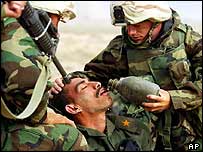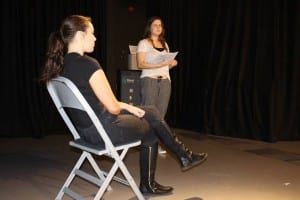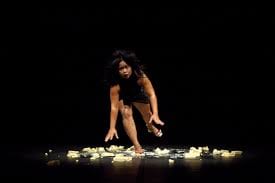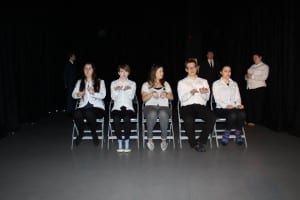Original concept.
Looking back to our very first discussions about where we would end up with or final performance is a memory of chaos and excitement combined. Our original idea was stemmed from the fact our show would have a lot of media in it therefore we looked into the representation of the media in today’s society. For example in today’s society the media can be extremely manipulated, in some cases in can be harmless for example photo-shopping celebrities to look good but in other cases it can be extreme for example:
This got us thinking about how the government can manipulate the way we see things and also how the media are always watching us, for example the recent phone hacking of celebrities and royalty scandal cropped up in conversation, this then led on to the discussion of how the government can always see what we are doing and how they can hack into our phone calls etc. Citizenfour (2014) was a stimulus that influenced our ideas that when you are aware you are being watched, you may act differently. This intrigued us and allowed us to look further into the extensive use of cctv footage in today’s society.
https://www.youtube.com/watch?v=6ADUs8iN7NE
I believe that this was our starting point for our original idea of doing a show about the GOD (Government of development) and how they are constantly watching us and manipulating the way we see things. We then expanded this idea by working on writing tasks such as ‘when I was six’ this task allowed us to attempt to develop characters with a background story.
The fact that ‘On the one hand, the vastly extended digital technologies of surveillance have fostered a culture in which people have a sense of being observed almost everywhere, all the time. Global satellite mapping, for example, has been criticised because of the coverage and details it now provides, almost intruding into individuals’ private homes and lives.’(Bbay-Cheng, 2010, 21). This was a turning point that made us reconsider our original idea. This was because our performance would be heavily based around technology and therefore we were already making a point that today’s society is heavily mediatised so it seemed pointless to make the point with the narrative of our performance as well as it was already obvious.
Our final idea.
After our discussions we eventually decided to portray the way in which media can manipulate our mind as ‘particularly relevant to the perspective of theatre and performance of this aspect of digital culture is the capacity to manipulate data in real time in a way which was not possible with earlier analogue technologies such as film. Thus, whilst the impact of the projection of moving images on pre-recorded film in live theatre events was utilised by predecessors such as Meyerhold and Piscator, the capacity for live feeds and manipulation of imagery in real time greatly extends the possibilities of contemporary theatre practices’ (Bay-Cheng, 2010, 16). Therefore this idea seemed to be an advantage as it would be easy to show manipulation with the use technology.
We decided to look at specific moments throughout history and use the technology we had to show unseen moments or alternative sides of the story. This could be done by the fact that the audience would be able to see what’s on stage but also a contradiction to that with what we presented on screen.
Fragmentation in performance.
When deciding on the structure of the scenes in our show we also had to consider how these scenes would be performed. As the order of the historical events we were putting in the show were not going to be in chronological order, it made the show fragmented, therefore we decided that the style of each scene could be different to fit in with fragmented mise-en-scen. As ‘Over the past 30 years, the study of the performing arts has embraced not only a broad spectrum of practices which were formerly categorised under other art disciplines but also a wide range of social activities under the banner of ‘performance’ that were previously considered aspects of everyday life’ (Bay-Cheng, 2010, 14), we decided to incorporate both practices into our show.
A particular scene that was extremely staged was the Watergate scene as this scene had many props to create a realistic effect as we tried to represent a version of the story of what may have happened before Nixon gave his 1972 leaving parliament speech, we also used cameras to highlight Jakes face as he was playing Nixon and therefore it was a way of showing his facial expressions up close. This scene was also scripted and rehearsed like any traditional play at the theatre would be and we spend a lot of time working on ways to create tension in the atmosphere. As we didn’t know Pat or Richard Nixon personally or what they were like behind closed doors it was hard to create a true representation of these people, therefore we took inspiration from Mackey and Cooper who state; ‘you may not initially recognise the atmosphere that you wish to create. It is quite appropriate that this arises during the rehearsal process. Then, tension and atmosphere can be enhanced through other elements of performance such as stillness’ (Mackey and Cooper, 2000, 52). Therefore we found that during our rehearsal process it was effective to be still for a while as a tension would automatically be created as audience members may think an actor/actress had forgotten their lines. This technique was simple but in my opinion successful.
A scene that created a big juxtaposition with this style of acting was the Suffragettes scene. This scene was extremely minimalistic; the only use of technology was the video and audio playing. No set was on the stage it was completely blank with only one actress performing. As the video showed the famous scene of Emily Dickinson who jumped in front of the queen’s horse in order to gain rights for women, the actress on stage represented this particular movement and threw herself onto the stage floor every time the loop video showed the collision of Emily Dickinson and the horse. This was successful as ‘through our movements we provide a rich performative, communicative visual expression onstage and in other unscripted scenarios’ (Hansen, 2013, 135). Therefore it was better for the scene to be minimal as the audience could focus on the real pain that was being caused which hopefully put them in an uncomfortable position as they were aware that the pain Georgie was being put through was real and therefore her reactions were also real.
A performance artist I thought inspired this piece was Melati Suryodarmo who created a performance where she had a very minimalistic set and stood and danced on butter, each time she fell during the performance she would get back up and continue very much like how Georgie did in this particular scene. When describing why she chose to perform this task Suryodarmo explained, ‘I also believe that everything happens in this world does not stop, even when we die. What we can deal with is the time that our body can adjust to the whole conception of time, whether it is physical or biological’ (Suryodarmo, 2000). This intrigued me as the suffragettes scene had an audio clip of women throughout history explaining why women must stand up proving that still today some woman do not feel as though they are treated with the same equality as men, therefore the pain that both performers bodies went through during these performances could physically represent the struggles that we may mentally go through throughout our lives.
Both Georgie and Suryodarmo were the artists the creators of their particular performances and acted completely as themselves performing their own body’s strengths therefore it is a lot different to rehearse scenes like this as opposed to a scripted scene. Instead of practising lines a scene like this would be more of a mental preparation for the pain. As ‘Movement is unique in the sense that we have a particular insight into other people’s bodies through the projection of our own (Wachsmuth et al. 2008) as well as having training from birth in navigating the complex situations that inter-personal communication creates’ (Hansen, 2013, 135) no lines were spoken or necessary. After her performance Georgie stood up and left completely emotionless. This highlighted the fact that it was just a performance mentally however her bruises and blood showed that physically it was real.
The theme of performing as ourselves ran throughout the show for example Charlotte our stage manager would go on stage during the performance to fix cameras ect, this showed how we were not aiming to pretend to be anyone other than ourselves. When we were acting as characters it was only to represent them not fool the audience that we were them.
‘One major impact which has led us to modify our primary understanding of theatre and performance is the way in which everyday life itself has, as noted, been widely re-conceived as performative.’ (Bay-Cheng, 2010, 21). Richard Schechner was also another inspiration for our performance as he believes that ‘performances are actions’ (2002, 1) and that actions in everyday life can be classed as performative. Therefore our opening scene had a row of performers doing the simple task of typing. At first this was completely naturalistic, however as time went on the typing became more ritualistic. This again from the beginning of the performance hinted at the audience that the show would be fragmented and had juxtapositions.
In our rehearsal process we practised the ensemble work by doing simple tasks such as walking from one side of the room to the other. This task may sound simple but to get our rhythm and pace all at the same time it took a lot of practice. One inspiration for this type of ensemble work was theatre company Complicite as ‘The Company are able to improvise their way seamlessly out of most situations without an audience realising if anything out of the ordinary has happened’ (Mangan, 2013, 60). This was important to us as we were going to be working with a lot of technology on the night of the performance and therefore anything could have gone wrong so if we were able to walk on stage in a performatively way it would not look messy and the audience would not be aware if there were any technical errors. We also did a lot of rehearsals that involved how we would take the props on and off stage which included perfecting the timing. Putting our efforts into these rehearsals committed to transactions ensured that we did not lose our audiences focus.
The Final show.
I believe our extensive rehearsal process and lengthily discussions paid off in the end as we presented a successful show. The way in which we used technology throughout fit in with our fragmented theme as in some scenes we added basic forms of technology and in others we made it more complex.
In the Watergate scene we showed how the media can present things we do not see ourselves in a simple form for example, when Jake played Nixon he had his back to the audience but we used cameras and screens to show his facial expressions. As Causey suggests; ‘The competition between live performer and mediated representation of that performer for the perception of the spectator ends up as a draw at best since the mediated subject is that “which has emerged from some primal separation, from some self-mutilation induced by the very approach of the real’ (Causey, 2006, 24). We thought staging the scene this way would be effective as the audience saw on stage a president known as a crook with his back to the audience which represented how he did not face responsibilities however on the screen his facial expressions when performing his monologue show the real character and how nervous he was deep down allowing the audience to get a different perceptive on this character.
Another way in which we used the technology in this scene was when we had a camera focused on some flowers that were not arranged correctly. This showed how ‘the mediated screens in live performance are both the opaque border of the representable object trapping the gaze of the perceiving subject before it apprehends the object’ (Causey, 2006, 389). The flowers represented the fact that in this scene things were not quite right, myself playing Pat was staring at these flowers until eventually she snapped and re-arranged them. This showed how she was under a lot of pressure and wanted everything small detail to be perfect therefore creating a tension. Without the camera focusing on the flowers the audience would not have seen the way they were arranged and therefore may not have understood why Pat was becoming agitated. Although simple and basic this usage of cameras was successful as it allowed the audience to see important details more clearly via the screens.
A scene in the final show that was heavily packed with technology was the scene representing the Columbine shootings. During this scene as well as having two actors on stage we also showed pre recordings of the full cast that was to represent the dead bodies of the people who had been shot in this tragedy. This is because, ‘Intermedial theatre may be both physically based and on-screen; experiences may be both actual and virtual; spaces may be both public and private; bodies may be both present and absent’ (Bay-Cheng, 2010, 17). On stage the two actors held guns that had a go pro camera attached to them. When the guns were aimed at the audience the cameras were too and the footage of the audience was shown on the screens. This was an example of how ‘performance, like the body and its subjectivity which embodies and enacts the performative, has been extended, challenged and reconfigured by way of its position in the space of technology. Performance has taken on the ontology of the technological. (Causey, 2006, 394).
WORKS CITED
Bay-Cheng, S. (2010). Mapping intermediality in performance. Amsterdam: Amsterdam University Press.
Causey, M. (2006). Theatre performance and technology. London: Routledge.
Hansen, Lise (2013) ‘Making Do and Making New: Performative Moves Into Interaction Design’ International Journal of Performance Arts & Digital Media 9:1 pp. 135-151
Mackey, S. and Cooper, S. (2000). Drama and theatre studies. Cheltenham: Stanley Thornes. Drama and theatre studies. Cheltenham: Stanley Thornes.
Mangan, M. (2013). The theatre, drama and performance companion. Basingstoke, GB: Palgrave Macmillan.
Schechner, R. (2002). Performance studies. London: Routledge.
Suryodarmo, M. (2000) Melati Suryodarmo HOME. [Online] Indonesia. Available from: http://www.melatisuryodarmo.com/works_Exergie_Butter_Dance.html




